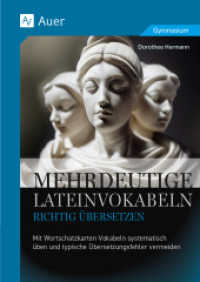- ホーム
- > 洋書
- > 英文書
- > Computer / General
Full Description
Path tracing is one of several techniques to render photorealistic images by simulating the physics of light propagation within a scene. The roots of path tracing are outside of computer graphics, in the Monte Carlo simulations developed for neutron transport. A great strength of path tracing is that it is conceptually, mathematically, and often-times algorithmically simple and elegant, yet it is very general. Until recently, however, brute-force path tracing techniques were simply too noisy and slow to be practical for movie production rendering. They therefore received little usage outside of academia, except perhaps to generate an occasional reference image to validate the correctness of other (faster but less general) rendering algorithms. The last ten years have seen a dramatic shift in this balance, and path tracing techniques are now widely used. This shift was partially fueled by steadily increasing computational power and memory, but also by significant improvements in sampling, rendering, and denoising techniques.
The Path to Path-Traced Movies provides the reader with an overview of path tracing and highlights important milestones in its development that have led to it becoming the preferred movie rendering technique today. It identifies major hurdles that stood in the way of that transition, describing the technical milestones that pushed the field forward over the last couple of decades, and discusses the combination of circumstances that came together to propel the CG and VFX movie industry into a path-traced world.
Since the journey is not yet complete, it also discusses on-going challenges and open questions that practitioners and researchers will need to address in the years to come.
Contents
1: Introduction
2: Illumination
3: Path Tracing
4: Other Rendering Techniques: A Retrospective
5: Advanced Path Tracing
6: Enabling Technology
7: Why Path Tracing and Why Now?
8: Extensions and Challenges
9: Discussion and Conclusion
Acknowledgements
References








